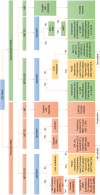Gastroenteropancreatic neuroendocrine neoplasms: A clinical snapshot
- PMID: 33796213
- PMCID: PMC7993001
- DOI: 10.4240/wjgs.v13.i3.231
Gastroenteropancreatic neuroendocrine neoplasms: A clinical snapshot
Abstract
Our understanding about the epidemiological aspects, pathogenesis, molecular diagnosis, and targeted therapies of neuroendocrine neoplasms (NENs) have drastically advanced in the past decade. Gastroenteropancreatic (GEP) NENs originate from the enteroendocrine cells of the embryonic gut which share common endocrine and neural differentiation factors. Most NENs are well-differentiated, and slow growing. Specific neuroendocrine biomarkers that are used in the diagnosis of functional NENs include insulin, glucagon, vasoactive intestinal polypeptide, gastrin, somatostatin, adrenocorticotropin, growth hormone releasing hormone, parathyroid hormone-related peptide, serotonin, histamine, and 5-hydroxy indole acetic acid (5-HIAA). Biomarkers such as pancreatic polypeptide, human chorionic gonadotrophin subunits, neurotensin, ghrelin, and calcitonin are used in the diagnosis of non-functional NENs. 5-HIAA levels correlate with tumour burden, prognosis and development of carcinoid heart disease and mesenteric fibrosis, however several diseases, medications and edible products can falsely elevate the 5-HIAA levels. Organ-specific transcription factors are useful in the differential diagnosis of metastasis from an unknown primary of well-differentiated NENs. Emerging novel biomarkers include circulating tumour cells, circulating tumour DNA, circulating micro-RNAs, and neuroendocrine neoplasms test (NETest) (simultaneous measurement of 51 neuroendocrine-specific marker genes in the peripheral blood). NETest has high sensitivity (85%-98%) and specificity (93%-97%) for the detection of gastrointestinal NENs, and is useful for monitoring treatment response, recurrence, and prognosis. In terms of management, surgery, radiofrequency ablation, symptom control with medications, chemotherapy and molecular targeted therapies are all considered as options. Surgery is the mainstay of treatment, but depends on factors including age of the individual, location, stage, grade, functional status, and the heredity of the tumour (sporadic vs inherited). Medical management is helpful to alleviate the symptoms, manage inoperable lesions, suppress postoperative tumour growth, and manage recurrences. Several molecular-targeted therapies are considered second line to somatostatin analogues. This review is a clinical update on the pathophysiological aspects, diagnostic algorithm, and management of GEP NENs.
Keywords: Chemotherapy; Gastroenteropancreatic neuroendocrine neoplasms; Neuroendocrine carcinoma; Neuroendocrine tumours; Octreoscan; Targeted molecular therapy.
©The Author(s) 2021. Published by Baishideng Publishing Group Inc. All rights reserved.
Conflict of interest statement
Conflict-of-interest statement: Authors declare no conflict of interests for this article.
Figures


References
-
- Ahlman H, Nilsson The gut as the largest endocrine organ in the body. Ann Oncol. 2001;12 Suppl 2:S63–S68. - PubMed
-
- Worthington JJ, Reimann F, Gribble FM. Enteroendocrine cells-sensory sentinels of the intestinal environment and orchestrators of mucosal immunity. Mucosal Immunol. 2018;11:3–20. - PubMed
-
- Pearse AG. The APUD concept and hormone production. Clin Endocrinol Metab. 1980;9:211–222. - PubMed
-
- Zandee WT, Kamp K, van Adrichem RC, Feelders RA, de Herder WW. Effect of hormone secretory syndromes on neuroendocrine tumor prognosis. Endocr Relat Cancer. 2017;24:R261–R274. - PubMed
-
- Perren A, Couvelard A, Scoazec JY, Costa F, Borbath I, Delle Fave G, Gorbounova V, Gross D, Grossma A, Jense RT, Kulke M, Oeberg K, Rindi G, Sorbye H, Welin S Antibes Consensus Conference participants. ENETS Consensus Guidelines for the Standards of Care in Neuroendocrine Tumors: Pathology: Diagnosis and Prognostic Stratification. Neuroendocrinology. 2017;105:196–200. - PubMed
Publication types
LinkOut - more resources
Full Text Sources
Other Literature Sources
Miscellaneous

